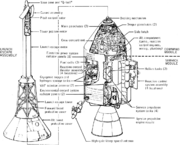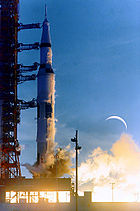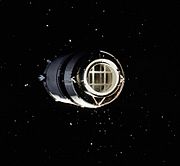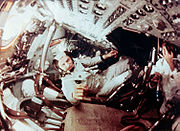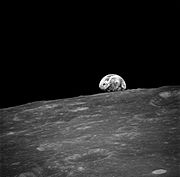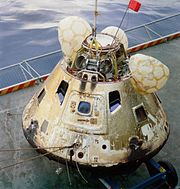
Apollo 8
About this schools Wikipedia selection
Arranging a Wikipedia selection for schools in the developing world without internet was an initiative by SOS Children. SOS Children is the world's largest charity giving orphaned and abandoned children the chance of family life.
| Apollo 8 | |||||
|---|---|---|---|---|---|
Mission insignia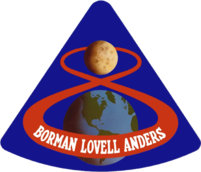 |
|||||
| Mission statistics | |||||
| Mission name | Apollo 8 | ||||
| Command Module | CM-103 mass 28,817 kg |
||||
| Service Module | SM-103 | ||||
| Lunar Module | Lunar Test Article (LTA-B) mass 9,026 kg |
||||
| Crew size | 3 | ||||
| Launch vehicle | Saturn V SA-503 | ||||
| Launch pad | LC 39A Kennedy Space Centre Florida, USA |
||||
| Launch date | 12:51:00, December 21, 1968 (UTC) | ||||
| Lunar orbits | 10 | ||||
| CSM time in lunar orbit | 20 h 10 m 13 s | ||||
| Landing | 15:51:42, December 27, 1968 (UTC) 8.7°N 165°1.2′WInvalid arguments have been passed to the {{#coordinates:}} function |
||||
| Mission duration | 6 d 03 h 00 m 42 s | ||||
| Crew photo | |||||
| 200px | |||||
| Left to right: Lovell, Anders, Borman | |||||
| Related missions | |||||
|
|||||
Apollo 8 was the first manned voyage to a celestial body. Its three-man crew of Mission Commander Frank Borman, Command Module Pilot James Lovell, and Lunar Module Pilot William Anders became the first humans to see the far side of the Moon. The mission also involved the first manned launch of a Saturn V rocket, and was the second manned mission of the Apollo Program.
Originally planned as a low-earth orbit Lunar Module/ Command Module test, the mission profile was changed to the more ambitious lunar orbital flight in August 1968 when the Lunar Module scheduled for the flight became delayed. The new mission's profile, procedures and personnel requirements left an uncharacteristically short time-frame for training and preparation.
After launching on December 21, 1968, the crew took three days to travel to the Moon. They orbited ten times over the course of 20 hours, during which the crew made a Christmas Eve television broadcast in which they read the first 10 verses from the Book of Genesis. At the time, the broadcast was the most watched TV program ever. Apollo 8's successful mission paved the way for Apollo 11 to fulfill U.S. President John F. Kennedy's goal of landing a man on the Moon before the end of the decade.
Crew
Number in parentheses indicates number of spaceflights by each individual prior to and including this mission.
- Frank F. Borman, II (2) - Commander (CDR)
- James A. Lovell, Jr (3) - Command Module Pilot (CMP)
- William A. Anders (1) - Lunar Module Pilot (LMP)
Lovell was originally the CMP on the back-up crew, with Michael Collins as the prime crew's CMP. However, he was replaced in July 1968, after suffering a cervical disc herniation that required surgery to repair.
Backup crew
- Neil A. Armstrong - Commander
- Edwin E. Aldrin, Jr - Command Module Pilot
- Fred W. Haise, Jr - Lunar Module Pilot
Originally, Lovell was the backup CMP, and Aldrin was backup LMP. When Lovell was rotated to the prime crew, no one with experience of CSM 103 (the specific spacecraft used for the mission) was available, so Aldrin was moved to CMP and Fred Haise brought in as backup LMP.
Mission control
The Earth-based mission control teams for Apollo 8 consisted of astronauts assigned to the support crew, as well as non-astronaut flight directors and their staffs. The support crew members were not trained to fly the mission, but were able to stand in for astronauts in meetings and be involved in the minutiae of mission planning, while the prime and backup crews trained. They also served as capcoms during the mission. For Apollo 8, these crew members included astronauts John S. Bull, Vance D. Brand, Gerald P. Carr, and Ken Mattingly. The mission control teams on Earth rotated in three shifts, each led by a flight director. The directors for Apollo 8 included Cliff Charlesworth (Green team), Glynn Lunney (Black team), and Milton Windler (Maroon team).
Mission insignia
The triangular shape of the insignia symbolizes the shape of the Apollo command module. It shows a red figure 8 looping around the earth and moon representing the mission number as well as the circumlunar nature of the mission. On the red number 8 are the names of the three astronauts.
The initial design of the insignia was developed by Jim Lovell. Lovell reportedly sketched the initial design while riding in the backseat of a T-38 flight from California to Houston, shortly after learning of the re-designation of the flight to become a lunar orbital mission.
Planning
In September 1967, the Manned Spacecraft Centre in Houston, Texas proposed a series of missions that would lead up to a manned lunar landing. Seven mission types were outlined, each testing a specific set of components and tasks, and each previous step would need to be completed successfully before the next mission type could be undertaken. These were:
- Unmanned Command/Service Module (CSM) test
- Unmanned Lunar Module (LM) test
- Manned CSM in low Earth orbit
- Manned CSM and LM in low Earth orbit
- Manned CSM and LM in an elliptical Earth orbit with an apogee of 4600 miles (7400 km)
- Manned CSM and LM in lunar orbit
- Manned lunar landing
Apollo 4 and Apollo 6 had been "A" missions, each launching an unmanned Block I production model of the Apollo Command and Service Modules into Earth Orbit. Apollo 7, scheduled for October 1968, would be a manned Earth Orbit flight of the CSM, completing the objectives for Mission "C".
Further missions relied on the readiness of the Lunar Module (LM). Production of the LM was behind schedule, with the first model arriving at Cape Canaveral in June 1968. Even then, significant defects were discovered, leading Grumman, the lead contractor for the LM, to predict that the first mission-ready LM would not be ready until at least February 1969. This would mean delaying the proposed "D" mission and endangering the program's goal of a lunar landing before the end of 1969.
George Low, the Manager of the Apollo Spacecraft Program Office, proposed a solution in August. Since the Command/Service Module (CSM) would be ready three months before the Lunar Module, a CSM-only mission could be flown in December 1968. Instead of just repeating the "C" mission flight of Apollo 7, this CSM could be sent all the way to the Moon, with the possibility of entering a lunar orbit. The new mission would also allow NASA to test lunar landing procedures that would otherwise have to wait until Apollo 10, the scheduled "F" mission.

Almost every senior manager at NASA agreed with this new mission, citing both confidence in the hardware and personnel, and the potential for a significant morale boost provided by a circumlunar flight. The only person who needed some convincing was James E. Webb, the NASA administrator. With the rest of his agency in support of the new mission, Webb eventually approved the mission change. The mission was officially changed from a "D" mission to a "C-Prime" Lunar Orbit mission, but was still referred to in press releases as an Earth Orbit mission at Webb's direction. No public announcement was made about the change in mission until November 12, three weeks after Apollo 7's successful Earth Orbit mission and less than 40 days before launch.
With the change in mission for Apollo 8, Director of Flight Crew Operations Deke Slayton decided to swap the crews of the D and E missions. James McDivitt, the original commander of the D mission, has said he was never offered the circumlunar flight, but would probably have turned it down, as he wanted to fly the lunar module. Borman, on the other hand, jumped at the chance: his original mission would just have been a repeat of the previous flight, except in a higher orbit. This swap also meant a swap of spacecraft, requiring Borman's crew to use CSM-103, while McDivitt's crew would use CSM-104.
On September 9, the crew entered the simulators to begin their preparation for the flight. By the time the mission flew, the crew would have spent seven hours training for every actual hour of flight. Although all crew members were trained in all aspects of the mission, it was necessary to specialize. Borman, as commander, was given training on controlling the spacecraft during the re-entry. Lovell was trained on navigating the spacecraft in case communication was lost with the Earth. Anders was placed in charge of checking that the spacecraft was in working order.
The crew, now living in the crew quarters at Kennedy Space Centre, received a visit from Charles Lindbergh and his wife, Anne Morrow Lindbergh, the night before the launch. They talked about how before his 1927 flight, Lindbergh had used a piece of string to measure the distance from New York City to Paris on a globe and from that calculated the fuel needed for the flight. The total was a tenth of the amount that the Saturn V would burn every second.
The next day, the Lindberghs watched the launch of Apollo 8 from a nearby dune. Anne Morrow Lindbergh would later write a book about the Apollo program, entitled Earth Shine, which mentions both the launch and the mission.
Saturn V
The Saturn V rocket used by Apollo 8 was designated SA-503, or the "03rd" model of the Saturn V ("5") Rocket to be used in the Saturn-Apollo ("SA") program. When it was erected in the Vertical Assembly Building on December 20, 1967, it was thought that the rocket would be used for an unmanned Earth-orbit test flight carrying a boilerplate Command/Service Module. Apollo 6 had suffered several major problems during its April 1968 flight, including severe pogo oscillation during its first stage, two second stage engine failures, and a third stage that failed to reignite in orbit. Without assurances that these problems had been rectified, NASA administrators could not justify risking a manned mission until additional unmanned test flights proved that the Saturn V was ready.
Teams from the Marshall Space Flight Centre (MSFC) went to work on the problems. Of primary concern was the pogo oscillation, which would not only hamper engine performance, but could exert significant g-forces on a crew. A task force of contractors, NASA agency representatives, and MSFC researchers concluded that the engines vibrated at a frequency similar to the frequency at which the spacecraft itself vibrated, causing a resonance effect that induced oscillations in the rocket. A system using Helium gas to absorb some of these vibrations was installed.
Of equal importance was the failure of three engines during flight. Researchers quickly determined that a leaking Hydrogen fuel line ruptured when exposed to vacuum, causing a loss of fuel pressure in engine two. When an automatic shutoff attempted to close the Liquid Hydrogen valve and shut down engine two, it accidentally shut down engine three's Liquid Oxygen due to a faulty igniter line. As a result, engine three failed within one second of engine two's shutdown. Further investigation revealed the same problem for the third-stage engine — a faulty igniter line. The team modified the igniter lines and fuel conduits, hoping to avoid similar problems on future launches.
The teams tested their solutions in August 1968 at the Marshall Space Flight Centre. A Saturn stage IC was equipped with shock absorbing devices to demonstrate the team's solution to the problem of pogo oscillation, while a Saturn Stage II was retrofitted with modified fuel lines to demonstrate their resistance to leaks and ruptures in vacuum conditions. Once NASA administrators were convinced that the problems were solved, they gave their approval for a manned mission using AS-503.
The Apollo 8 spacecraft was placed on top of the rocket on September 21 and the rocket made the slow 3-mile (5 km) journey to the launch pad on October 9. Testing continued all through December until the day before launch, including various levels of readiness testing from 5 December through 11 December. Final testing of modifications to address the problems of pogo oscillation, ruptured fuel lines, and bad igniter lines took place on 18 December, a mere three days before the scheduled launch.
Mission
Launch and trans-lunar injection
Apollo 8 launched at 7:51:00 a.m. Eastern Standard Time on December 21, 1968, using the Saturn V's three stages, S-IC, S-II, and S-IVB, to achieve Earth orbit. The launch phase experienced only three minor problems: The engines of the first stage, S-IC, underperformed by 0.75%, causing the engines to burn for 2.45 seconds longer than planned, and toward the end of the second stage burn, S-II, the rocket underwent pogo oscillations. Frank Borman estimated the oscillations were approximately 12 Hertz and ±0.25 g (±2.5 m/s²). The apogee was also slightly higher than the planned circular orbit of 115 miles (185 km). In its first manned mission, the Saturn V rocket placed Apollo 8 into a 112.8 miles by 118.9 miles (181.5 km by 191.3 km) Earth orbit within 88 minutes and 10 seconds.
All three rocket stages fired during launch; the S-IC and S-II detached during launch. The S-IC impacted the Atlantic Ocean at 30°12′N 74°7′W and the S-II second stage at 31°50′N 37°17′W. The third stage of the rocket, S-IVB, assisted in driving the craft into Earth orbit but remained attached to later perform the Trans-Lunar Injection (TLI), the burn that would put the spacecraft on a trajectory to the Moon.
Once in Earth orbit, both the Apollo 8 crew and Mission Control spent the next 2 hours and 38 minutes checking that the spacecraft was in proper working order and ready for TLI. At the same time, the Apollo 8 crew transformed the capsule from a rocket payload into a spacecraft. The proper operation of third stage of the rocket, S-IVB was crucial; In the last unmanned test, the S-IVB had failed to re-ignite for TLI.
During the flight, three fellow astronauts served on the ground as capsule communicators (usually referred to as "CAPCOMs") on a rotating schedule. The CAPCOMs were the only people who regularly communicated with the crew. Michael Collins was the first CAPCOM on duty and at 2 hours, 27 minutes and 22 seconds after launch radioed, "Apollo 8. You are Go for TLI". This communication signified that Mission Control had given official permission for Apollo 8 to go to the moon. Over the next twelve minutes before the TLI burn, the Apollo 8 crew continued to monitor the spacecraft and the rocket. The S-IVB third stage rocket ignited on time and burned perfectly for 5 minutes and 17 seconds. The burn increased the velocity of Apollo 8 to 35,505 feet per second (10,822 m/s) and the spacecraft's altitude at the end of the burn was 215.4 miles (346.7 km). At this time, the crew also set the record for the highest speed humans had ever traveled.
After the S-IVB had performed its required tasks, it was jettisoned. The crew then rotated the spacecraft to take some photographs of the spent stage and then practiced flying in formation with it. As the crew rotated the spacecraft, they had their first views of the Earth as they moved away from it. This marked the first time humans could view the entire Earth at once. Borman became worried that the S-IVB was staying too close to the Command/Service Module and suggested to Mission Control that the crew perform a separation maneuver. Mission Control first suggested pointing the spacecraft towards Earth and using the Reaction Control System (RCS) thrusters on the Service Module to add 3 ft/s (0.9 m/s) away from the Earth, but Borman did not want to lose sight of the S-IVB. After discussion, the crew and Mission Control decided to burn in this direction, but at 9 ft/s (2.7 m/s) instead. These discussions put the crew an hour behind their flight plan.
Five hours after launch, Mission Control sent a command to the S-IVB booster to vent its remaining fuel through its engine bell to change the booster's trajectory. This S-IVB would then pass the Moon and enter into a solar orbit, posing no further hazard to Apollo 8. The S-IVB subsequently went into a 0.99 by 0.92 AU solar orbit with an inclination of 23.47° and a period of 340.80 days.
The Apollo 8 crew were the first humans to pass through the Van Allen radiation belts, which extend up to 15,000 miles (25,000 km) from Earth. Scientists predicted that passing through the belts quickly at the spacecraft's high speed would cause a radiation dosage of no more than a chest X-ray, or 1 milligray (during the course of a year, the average human receives a dose of 2 to 3 mGy). To record the actual radiation dosages, each crew member wore a Personal Radiation Dosimeter that transmitted data to Earth as well as three passive film dosimeters that showed the cumulative radiation experienced by the crew. By the end of the mission, the crew experienced an average radiation dose of 1.6 mGy.
Lunar trajectory
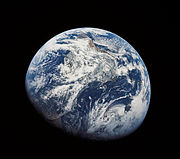
Jim Lovell's main job as Command Module Pilot was as navigator. Although Mission Control performed all of the actual navigation calculation, it was necessary to have a crew member serving as navigator so that the crew could successfully return to Earth in case of communication loss with Mission Control. Lovell navigated by star sightings using a sextant built into the spacecraft, measuring the angle between a star and the Earth's (or the Moon's) horizon. This task proved to be difficult, as a large cloud of debris around the spacecraft formed by the venting S-IVB made it hard to distinguish the stars.
By seven hours into the mission, the crew was about one hour and 40 minutes behind flight plan due to the issues of moving away from the S-IVB and Lovell's obscured star sightings. The crew now placed the spacecraft into Passive Thermal Control (PTC), also known as "barbecue" mode. PTC involved the spacecraft rotating about once per hour along its long axis to ensure even heat distribution across the surface of the spacecraft. In direct sunlight, the spacecraft could be heated to over 200 °C while the parts in shadow would be −100 °C. These temperatures could cause the heat shield to crack or propellant lines to burst. As it was impossible to get a perfect roll, the spacecraft actually swept out a cone as it rotated. The crew had to make minor adjustments every half hour as the cone pattern got larger and larger.
The first mid-course correction came 11 hours into the flight. Testing on the ground had shown the that the Service Propulsion System (SPS) engine had a small chance of exploding when burned for long periods unless its combustion chamber was "coated" first. Burning the engine for a short period would accomplish coating. This first correction burn was only 2.4 seconds and added about 20.4 ft/s (6.2 m/s) prograde (in the direction of travel). This change was less than the planned 24.8 ft/s (7.5 m/s) due to a bubble of helium in the oxidizer lines causing lower than expected fuel pressure. The crew had to use the small Reaction Control System (RCS) thrusters to make up the shortfall. Two later planned mid-course corrections were canceled as the Apollo 8 trajectory was found to be perfect.
Eleven hours into the flight, the crew had been awake for over 16 hours. Before launch, NASA had decided that at least one crew member should be awake at all times to deal with any issues that might arise. Borman started the first sleep shift, but between the constant radio chatter and mechanical noises, he found sleep difficult.
About an hour after starting his sleep shift, Borman requested clearance to take a Seconal sleeping pill. However, the pill had little effect. Borman eventually fell asleep but then awoke feeling ill. He vomited twice and had a bout of diarrhea that left the spacecraft full of small globules of vomit and feces that the crew cleaned up to the best of their ability. Borman initially decided that he did not want everyone to know about his medical problems, but Lovell and Anders wanted to inform Mission Control. The crew decided to use the Data Storage Equipment (DSE), which could tape voice recordings and telemetry and dump them to Mission Control at high speed. After recording a description of Borman's illness they requested that Mission Control check the recording, stating that they "would like an evaluation of the voice comments".
The Apollo 8 crew and Mission Control medical personnel held a conference using an unoccupied second floor control room (there were two identical control rooms in Houston on the second and third floor, only one of which was used during the course of a mission). The conference participants decided that there was little to worry about and that Borman's illness was either a 24-hour flu, as Borman thought, or a reaction to the sleeping pill. Researchers now believe that he was suffering from space adaptation syndrome, which affects about a third of astronauts during their first day in space as their vestibular system adapts to weightlessness. Space adaptation syndrome had not been an issue on previous spacecraft ( Mercury and Gemini), as those astronauts were unable to move freely in the comparatively smaller cabins of those spacecraft. The increased cabin space in the Apollo Command Module afforded astronauts greater freedom of movement, contributing to symptoms of spacesickness for Borman and, later, astronaut Russell Schweickart during Apollo 9.
The cruise phase was a relatively uneventful part of the flight, except for the crew checking that the spacecraft was in working order and that they were on course. During this time, NASA scheduled a television broadcast for 31 hours after launch. The Apollo 8 crew used a 2 kg camera that broadcast in black-and-white only, using a Vidicon tube. The camera had two lenses, a very wide-angle (160°) lens, and a telephoto (9°) lens.
During this first broadcast, the crew gave a tour of the spacecraft and attempted to show how the Earth appeared from space. However, difficulties aiming the narrow-angle lens without the aid of a monitor to show what it was looking at made showing the Earth impossible. Additionally, the Earth image became saturated by any bright source without proper filters. In the end, all the crew could show the people watching back on Earth was a bright blob. After broadcasting for 17 minutes, the rotation of the spacecraft took the high-gain antenna out of view of the receiving stations on Earth and they ended the transmission with Lovell wishing his mother a happy birthday.
By this time, the crew had completely abandoned the planned sleep shifts. Lovell went to sleep 32½ hours into the flight — 3½ hours before he had planned to. A short while later, Anders also went to sleep after taking a sleeping pill.
The crew was unable to see the Moon for much of the outward cruise. Two factors made the Moon almost impossible to see from inside the spacecraft: three of the five windows fogging up due to out-gassed oils from the silicone sealant, and the attitude required for the PTC. It was not until the crew had gone behind the Moon that they would be able to see it for the first time.
The Apollo 8 made a second television broadcast at 55 hours into the flight. This time, the crew rigged up filters meant for the still cameras so they could acquire images of the Earth through the telephoto lens. Although difficult to aim, as they had to maneuver the entire spacecraft, the crew was able to broadcast back to Earth the first television pictures of the Earth. The crew spent the transmission describing the Earth and what was visible and the colors they could see. The transmission lasted 23 minutes.
Lunar sphere of influence
At about 55 hours and 40 minutes into the flight, the crew of Apollo 8 became the first humans to enter the gravitational sphere of influence of another celestial body. In other words, the effect of the Moon's gravitational force on Apollo 8 became stronger than that of the Earth. At the time it happened, Apollo 8 was 38,759 miles (62,377 km) from the Moon and had a speed of 3,990 ft/s (1,216 m/s) relative to the Moon. This historic moment was of little interest to the crew since they were still calculating their trajectory with respect to the launch pad at Kennedy Space Centre. They would continue to do so until they performed their last mid-course correction, switching to a reference frame based on ideal orientation for the second engine burn they would make in lunar orbit. It was only thirteen hours until they would be in lunar orbit.
The last major event before Lunar Orbit Insertion was a second mid-course correction. It was in retrograde (against direction of travel) and slowed the spacecraft down by 2.0 ft/s (0.6 m/s), effectively lowering the closest distance that the spacecraft would pass the moon. At exactly 61 hours after launch, about 24,200 miles (39,000 km) from the Moon, the crew burned the RCS for 11 seconds. They would now pass 71.7 miles (115.4 km) from the lunar surface.
At 64 hours into the flight, the crew began to prepare for Lunar Orbit Insertion-1 (LOI-1). This maneuver had to be performed perfectly, and due to orbital mechanics had to be on the far side of the Moon, out of contact with the Earth. After Mission Control was polled for a Go/No Go decision, the crew was told at 68 hours, they were Go and "riding the best bird we can find". At 68 hours and 58 minutes, the spacecraft went behind the Moon and out of radio contact with the Earth.
With 10 minutes before the LOI-1, the crew began one last check of the spacecraft systems and made sure that every switch was in the correct place. At that time, they finally got their first glimpses of the Moon. They had been flying over the unlit side, and it was Lovell who saw the first shafts of sunlight obliquely illuminating the lunar surface. The LOI burn was only two minutes away, so the crew had little time to appreciate the view.
Lunar orbit
The SPS ignited at 69 hours, 8 minutes, and 16 seconds after launch and burned for 4 minutes and 13 seconds, placing the Apollo 8 spacecraft in orbit around the Moon. The crew described the burn as being the longest four minutes of their lives. If the burn had not lasted exactly the correct amount of time, the spacecraft could have ended up in a highly elliptical lunar orbit or even flung off into space. If it lasted too long they could have impacted the Moon. After making sure the spacecraft was working, they finally had a chance to look at the Moon, which they would orbit for the next 20 hours.
On Earth, Mission Control continued to wait. If the crew had not burned the engine or the burn had not lasted the planned length of time, the crew would appear early from behind the Moon. However, this time came and went without Apollo 8 reappearing. Exactly at the predicted moment, the signal was received from the spacecraft, indicating it was in a 193.3 mile by 69.5 mile (311.1 km by 111.9 km) orbit about the Moon.
After reporting on the status of the spacecraft, Lovell gave the first description of what the lunar surface looked like:
| “ | The Moon is essentially grey, no colour; looks like plaster of Paris or sort of a grayish beach sand. We can see quite a bit of detail. The Sea of Fertility doesn't stand out as well here as it does back on Earth. There's not as much contrast between that and the surrounding craters. The craters are all rounded off. There's quite a few of them, some of them are newer. Many of them look like — especially the round ones — look like hit by meteorites or projectiles of some sort. Langrenus is quite a huge crater; it's got a central cone to it. The walls of the crater are terraced, about six or seven different terraces on the way down. | ” |
Lovell continued to describe the terrain they were passing over. One of the crew's major tasks was reconnaissance of planned future landing sites on the Moon, especially one in Mare Tranquillitatis that would be the Apollo 11 landing site. The launch time of Apollo 8 had been chosen to give the best lighting conditions for examining the site. A film camera had been set up in one of the spacecraft windows to record a frame every second of the Moon below. Bill Anders spent much of the next 20 hours taking as many photographs as possible of targets of interest. By the end of the mission the crew had taken 700 photographs of the Moon and 150 of the Earth.
Throughout the hour that the spacecraft was in contact with Earth, Borman kept asking how the data for the SPS looked. He wanted to make sure that the engine was working and could be used to return early to the Earth if necessary. He also asked that they receive a Go/No Go decision before they passed behind the Moon on each orbit.
As they reappeared for their second pass in front of the Moon, the crew set up the equipment to broadcast a view of the lunar surface. Anders described the craters that they were passing over. At the end of this second orbit they performed the eleven-second LOI-2 burn of the SPS to circularize the orbit to 70.0 miles by 71.3 miles (112.6 km by 114.8 km).
Through the next two orbits, the crew continued to keep check of the spacecraft and to observe and photograph the Moon. During the third pass, Borman read a small prayer for his church. He was scheduled to participate in a service at St. Christopher's Episcopal Church near Seabrook, Texas, but due to the Apollo 8 flight was unable. A fellow parishioner and engineer at Mission Control, Rod Rose, suggested that Borman read the prayer which could be recorded and then replayed during the service.
Earthrise
When the spacecraft came out from behind the Moon for its fourth pass across the front, the crew witnessed an event no one had ever seen — Earthrise. Anders glanced out the window and saw a blue and white orb and realized it was the Earth. The crew recognized the significance of the event and the need to take photographs. Anders took both the first photograph, which was black-and-white, and later, the more famous colour photo (NASA image AS8-14-2383HR). (After the flight, Borman and Anders both claimed they took the first Earthrise photo — Lovell also did, more as a joke than anything else — but it was determined that it was probably Anders.) Due to the synchronous rotation of the Moon about the Earth, Earthrise is not generally visible from the Lunar surface. Earthrise is generally only visible when orbiting the Moon, other than at selected places near the Moon's limb, where libration carries the Earth slightly above and below the lunar horizon.
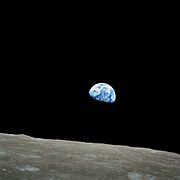
Anders continued to take photographs while Lovell assumed control of the spacecraft so Borman could rest. Despite the difficulty resting in the cramped and noisy capsule, Borman was able to sleep for two orbits, awakening periodically to ask questions about their status.
Borman awoke fully, however, when he started to hear his fellow crew members make mistakes. They were beginning to not understand questions and would have to ask for the answers to be repeated. Borman realized that everyone was extremely tired having not had a good night's sleep in over three days. Taking command, he ordered Anders and Lovell to get some sleep and that the rest of the flight plan regarding observing the Moon be scrubbed. At first Anders protested saying that he was fine, but Borman would not be swayed. At last Anders agreed as long as Borman would set up the camera to continue to take automatic shots of the Moon. Borman also remembered that there was a second television broadcast planned, and with so many people expected to be watching he wanted the crew to be alert. For the next two orbits Anders and Lovell slept while Borman sat at the helm. On subsequent Apollo missions, crews would avoid this situation by sleeping on the same schedule.
As they rounded the Moon for the ninth time, the second television transmission began. Borman introduced the crew, followed by each man giving his impression of the lunar surface and what it was like to be orbiting the Moon. Borman described it as being "a vast, lonely, forbidding expanse of nothing." Then, after talking about what they were flying over, Anders said that the crew had a message for all those on Earth. Each man on board read the story of creation from Book of Genesis. Borman finished the broadcast by wishing a Merry Christmas to everyone on Earth. His message appeared to sum up the feelings that all three crewmen had from their vantage point in lunar orbit. Borman said, "And from the crew of Apollo 8, we close with good night, good luck, and a Merry Christmas to all of you, all of you on the good Earth".
The only task left for the crew at this point was to perform the Trans-Earth Injection (TEI), which was scheduled for 2½ hours after the end of the television transmission. The TEI was the most critical burn of the flight, as any failure of the SPS to ignite would strand the crew in Lunar orbit, with little hope of escape. As with the previous burn, the crew had to perform the maneuver above the far side of the Moon, out of contact with Earth.
The burn occurred exactly on time. The spacecraft telemetry was reacquired as it re-emerged from behind the Moon at 89 hours, 28 minutes, and 39 seconds, the exact time predicted. When voice contact was regained, Lovell announced, "Please be informed, there is a Santa Claus", to which Ken Mattingly, the current CAPCOM, replied, "That's affirmative, you are the best ones to know". The spacecraft began its journey back to Earth on December 25, Christmas Day.
Unplanned manual re-alignment
Later, Lovell used some otherwise idle time to do some navigational sightings, maneuvering the module to view various stars by using the computer keyboard. However, he accidentally erased some of the computer's memory, which caused the inertial measuring unit (IMU) to think the module was in the same relative position it had been in before lift-off and fire the thrusters to "correct" the module's attitude.
Once the crew realized why the computer had changed the module's attitude, they realized they would have to re-enter data that would tell the computer its real position. It took Lovell ten minutes to figure out the right numbers, using the thrusters to get the stars Rigel and Sirius aligned, and another fifteen minutes to enter the corrected data into the computer.
Sixteen months later, Lovell would once again have to perform a similar manual re-alignment, under more critical conditions, during the Apollo 13 mission, after that module's IMU had to be turned off to conserve energy. In his 1994 book, Lost Moon: The Perilous Voyage of Apollo 13, Lovell wrote, "My training [on Apollo 8] came in handy!". In that book he dismissed the incident as a "planned experiment", requested by the ground crew. However, in subsequent interviews Lovell has acknowledged that the incident was an accident, caused by his mistake.
Cruise back to Earth and re-entry
The cruise back to Earth was mostly a time for the crew to relax and monitor the spacecraft. As long as the trajectory specialists had calculated everything correctly, the spacecraft would re-enter 2½ days after TEI and splashdown in the Pacific.
On Christmas afternoon, the crew made their fifth and final television broadcast. This time they gave a tour of the spacecraft, showing how an astronaut lived in space. When they had finished broadcasting they found a small present from Deke Slayton in the food locker—real turkey with stuffing and three miniature bottles of brandy (which remained unopened). There were also small presents to the crew from their wives.
After two uneventful days the crew prepared for re-entry. The computer would control the re-entry and all the crew had to do was put the spacecraft in the correct attitude, blunt end forward. If the computer broke down, Borman would take over.
Once the Command Module was separated from the Service Module, the astronauts were committed to re-entry. Six minutes before they hit the top of the atmosphere, the crew saw the Moon rising above the Earth's horizon, just as had been predicted by the trajectory specialists. As they hit the thin outer atmosphere they noticed it was becoming hazy outside as glowing plasma formed around the capsule. The capsule started slowing down and the deceleration peaked at 6 g (59 m/s²). With the computer controlling the descent by changing the attitude of the capsule, Apollo 8 rose briefly like a skipping stone before descending to the ocean. At 30,000 feet (9 km) the drogue parachute stabilized the spacecraft and was followed at 10,000 feet (3 km) by the three main parachutes. The spacecraft splashdown position was estimated to be 8°6′N 165°1′W.
When it hit the water, the parachutes dragged the spacecraft over and left it upside down, in what was termed Stable 2 position. As they were buffeted by a 10-foot (3 m) swell, Borman was sick, waiting for the three flotation balloons to right the capsule. It was 43 minutes after splashdown before the first frogman from the USS Yorktown arrived, as the capsule had landed before sunrise. Forty-five minutes later, the crew was safe on the deck of the aircraft carrier.
The command module is now displayed at the Chicago Museum of Science and Industry, along with a collection of personal items from the flight donated by Lovell and the spacesuit worn by Frank Borman. Jim Lovell's spacesuit can be found at NASA's Glenn Research Centre.
Historical importance
Apollo 8 came at the end of 1968, a year that had seen much upheaval around the world. Yet, TIME magazine chose the crew of Apollo 8 as their Men of the Year for 1968, recognizing them as the people who most influenced events in the preceding year. They had been the first people ever to leave the gravitational influence of the Earth and orbit another celestial body. They had survived a mission that even the crew themselves had rated as only having a fifty-fifty chance of fully succeeding. The effect of Apollo 8 can be summed up by a telegram from a stranger, received by Borman after the mission, that simply stated, "Thank you Apollo 8. You saved 1968."
One of the most famous aspects of the flight was the Earthrise picture that was taken as they came around for their fourth orbit of the Moon. Although it was not the first image taken of the whole Earth nor would it be the last, this was the first time that humans had taken such a picture. Some regard the picture as being the start of the environmentalist movement, with the first Earth Day in 1970.
The mission was the most widely covered by the media since the first American orbital flight, Mercury-Atlas 6 by John Glenn in 1962. There were 1200 journalists covering the mission, with the BBC coverage being broadcast in 54 countries in 15 different languages. The Soviet newspaper Pravda featured a quote from Boris Nikolaevich Petrov, Chairman of the Soviet Intercosmos program, who described the flight as an "outstanding achievement of American space sciences and technology". It is estimated that a quarter of the people alive at the time saw — either live or delayed — the Christmas Eve transmission during the ninth orbit of the Moon. Touring the world after the mission, Borman met with Pope Paul VI who told him "I have spent my entire life trying to say to the world what you did on Christmas Eve."
Atheist Madalyn Murray O'Hair later caused controversy by bringing a lawsuit against NASA over the reading from Genesis. O'Hair wished the courts to ban US astronauts — who were all Government employees — from public prayer in space. Though the case was rejected by the US Supreme Court for lack of jurisdiction, it caused NASA to be skittish about the issue of religion throughout the rest of the Apollo program. Buzz Aldrin, on Apollo 11, took communion on the surface of the moon after landing; he refrained from mentioning this publicly for several years, and only obliquely referred to it at the time.
In 1969, the US Postal Service issued a postage stamp ( Scott # 1371) commemorating the Apollo 8 flight around the moon. The stamp featured a detail of the famous photograph of the Earthrise over the moon taken by Anders on Christmas Eve, and the words, "In the beginning God..."
Mission parameters
The mission parameters for Apollo 8 differed significantly from those of previous flights, for several reasons. As the first manned spacecraft to orbit multiple celestial bodies, the mission recorded two different sets of orbital parameters. The mission was also the first to execute a translunar injection.
While in parking orbit around the Earth, Apollo 8 maintained altitude between a perigee of 112.8 miles (181.5 km) and an apogee of 118.9 miles (191.3 km). The inclination of this orbit, or its angle in relation to the equator, was 32.51°. Each orbit had a period of 88.17 minutes.
In contrast, the spacecraft orbited the Moon at more varying altitudes. At its lowest altitude above the moon's surface, the spacecraft had a pericynthion of 69.5 miles (111.9 km), while the highest altitude, or apocynthion, was 193.3 miles (311.1 km). The spacecraft took 128.7 minutes to complete each of its 10 circuits around the Moon, at an inclination of 12°.
The spacecraft began its translunar injection burn on December 21, 1968, at 15:41:38 UTC. The burn represented the second of two burns on the Saturn V rocket's S-IVB third stage. The rocket burned for a total of 318 seconds, propelling the 63,531 lb (28,817 kg) spacecraft from an Earth parking orbit velocity of 25,567 ft/s (7793 m/s) to a translunar trajectory velocity of 35,505 ft/s (10,822 m/s).
In film
Apollo 8's historic mission has been shown and referenced in several forms, both documentary and fiction. The various television transmissions and 16 mm footage shot by the crew of Apollo 8 was compiled and released by Spacecraft Films as a three-disc DVD set in 2003. Portions of the Apollo 8 Mission can be seen in the 1989 documentary For All Mankind, which won the Grand Jury Prize at the Sundance Film Festival for Outstanding Documentary.
Portions of the Apollo 8 mission are dramatized in the miniseries From the Earth to the Moon episode "1968". The S-IVB stage of Apollo 8 was also portrayed as the location of an alien device in the 1970 UFO episode "Conflict".
